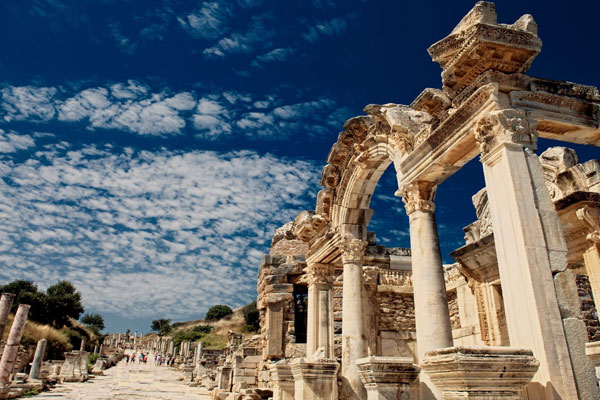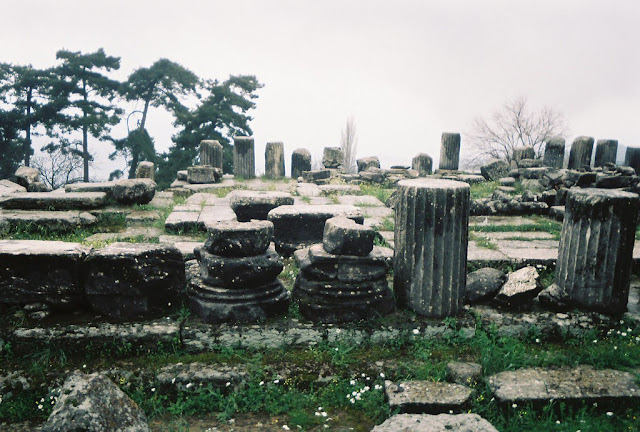THE ENTIRE PLANET IS ELLAS (GREECE) PART 1: IONIA – ASIA MINOR


Artemisium - Ephesus
Ephesus is an ancient city of Asia Minor on the coast of the Aegean. Around the 8th Century B.C. Ephesus became the economic centre of Asia Minor. In 334 B.C. it was liberated by the armies of Alexander the Great against the Persian occupation. Ephesus was the city dedicated to the goddess Artemis. The city was home to the Temple of Artemis, also known as Artemisium. The temple is one of the Seven ancient Wonders of the world.




The Temple of Apollo - Didyma
Didyma was a very important sacred ancient monument and oracle dedicated to Apollo and Artemis. It was the 2nd most important oracle of Apollo after the famous Oracle of Delphi. According to Pausanias, Didyma were constructed by the Ellenes during the 10th century B.C. Archaeologists today say that their Ellene history dates back to 2000 B.C. The sacred site was founded at the southernmost point of Miletus. Today, the Turkish village Yenihisar and the small turkish city of Didim are located near it.




Tetrapylon - Afrodisias
Afrodisias is found east of Kos in the Turkish city of Karacasus. The site is dedicated to the goddess Aphrodite, which also houses the sacred Temple of Aphrodite.




The Altar of Dias (Zeus) - Bergama
The Altar of Zeus was created in 197 B.C. by the Ellene general Eumenes in honour of Pergamon for his victory over the Galatians. It was a 2nd Acropolis of the ancient world due to its exquisite location at the highest point of the city. During the Byzantine period, this incredible temple was destroyed and its marbles were used for the defensive walls of the Byzantines!!




The Temple of Apollo - Side
Side is a magnificent trading port on the coast of Pamphylia. It was one of the most dominant cities of the region in ancient times. The establishment of ancient Side can be traced back to mythology. More precisely, after the end of the Trojan War around 1200 B.C. A group of Ellenes moved inland and settled in the region naming it "Pamphylia". According to myth, the leaders of this migration were the well-known seers Mopsus, Chalchas and Amphycus.
Note: MYTHOLOGY is true history passed down by word of mouth, while Paramyths are fairytales and made-up stories. There is a clear distinction between Mythology and Paramyths.





The Temple of Athena - Assos
The city of Assos was established around 1000-900 B.C. by the Aeolian people of Mithymna, Lesbos. The settlers built a Doric Temple of Athena at the mountain peak around 530 B.C.




The Temple of Athena - Priene
Priene is 1 of the 12 ancient Ionian cities (a.k.a. Ionian League) at the foothills of Mycale near the Latmio Bay. It was a Theban settlement home to Aepytus, Nilus and Philotas from Thebes. Its peak was during the 6th century B.C. whose leader was Bias of Priene, one of the seven sages of antiquity.
The Temple of Athena was completed under the command of Alexander the Great.




The Temple of Apollo - Claros
Claros is a famous sacred site and oracle of Apollo. Claros is approximately 2km from the oceanside, even though during ancient times it reached up until the coast. A compelling fact is its source of drinkable water found very close to the coast.
Claros was not an autonomous city. Politically, it belonged to the city of Colophon (either the old Colophon located inland 15km north, or the southern one located about 2km south of Claros). The hiereiai and helpers of the oracle were also residents of Colophon.
The sacred site is honoured to both Apollo and Dionysus. Near this sacred site, was the existence of the sundial during the same period.








The Temple of Apollo - Alexandreia
Alexandreia Troas is located on the western coast of Troad, opposite Tenedos. Its northern region shared its border with Ilion (falsely promoted as Troy), easterly with Scepsis and the valley of the Scamander river, and southernly with Assos. During the 4th century B.C. most of its population were of Aeolian descent. The city was renamed Alexandreia around 301 B.C. by Lysimachus, who wanted to show his respect towards Alexander the Great. Initially, however, it was named Antigonia by its founder Antigonus I Monophthalmus. The Sanctuary of Smintheos Apollo was a vital sacred site of the region. It was known to Homer and functioned up until the Roman period outside of Alexandreia.
Note: TROY is the alliance of all the apostate fiends of Chaos who attempted to violate the Space and environment of our Creation in order to damage and bring chaos to all the planes and levels of our Creation. It is NOT the name of the city that the apostate fiends of Chaos have promoted. The city was actually named “Ilion” «ιλιον», hence the name of Homer’s Epic “The Iliad”. The etymology of the word TROY means «τρΩεσ» = «τρΩΩ» (Troo: Eat) = Those that EAT absolutely anything they find, which is a characteristic of the apostate fiends and their hybrids. Note that Hybrid «ΥΒΡΙΔΙΟ» (Hybridio) etymologically means the “Hubris” (Hybri-) against DIAS (or Dios), who is the Universal Nous and the Value of Logic.




The Temple of Aphrodite - Knidos
Knidos was a settlement by the Lacedaemonians at cape Triopium of Caria, where most of its area is built in the Asia Minor region and the rest is built upon a small skerry that connects with the mainland with an embankment that outlines two harbours, one of which the settlers utilised for the building of war ships and the other for trade. The remnants of the Temple of Aphrodite of Knidos was located in between the two harbours. The structure was built in a circular fashion 17m in diameter. The sculpture of the goddess was found within the temple. When the doors opened, the sculpture of the goddess welcomed the worshippers. Today, only the pedestal of the sculpture is found there.




\
The Temple of Dias (Zeus) - Euromus
Evromos is the ancient city of Caria built on the foot of Mount Grium in Asia Minor. The river Kyvirsos passed through the city and the cities Priini, Miletus and the estuary of Meander were located nearby. Today, it is found near the province of Mugla, Turkey where a part of the ancient theatre still exists, as well as the wall, the Temple of Dias (Zeus), remnants of the agora and other buildings.
It is unknown when the city was established as it is archaic. According to mythology, the city was founded by Euromus. Most reputable is the Temple of Zeus of Lepsinos, which was built during the years of Hadrian.





The Temple of Dionysus - Teos
Teos was an important sea port on the coast of Ionia. Its ruins are located to the south of the modern town of Sığacık, approximately 30km from Smyrna. The god Dionysus is the protector of Teos who is honoured as the founder of the city. Other important events at Teos include the Heraclea and Dia in honour of Hercules and Dias (Zeus) respectively.





Miletus
Miletus was a very important city of Ionia during ancient times.
There are many mythological accounts in regards to the founding of the city. According to Pausanias, the first settlers were native Carians accompanied by Cretans from Miletus sent by Minos. The Minoans lived together with the Carians and settled together in the city which changed its name from Anaktoria to Miletus. The most important site is the Temple of the Delphic Apollo in the port region. There are little remnants of this archaic site of Apollo. It was maintained even after the Persian invasion during the 5th century B.C. It was an outdoor shrine, with an alter at the centre. But the great temples of the Archaic period include the Temple of Athena at the centre of Hersonissos , the Temple of Dionysus and the Temple of Artemis.





THE IMAGES SPEAK FOR THEMSELVES.
WHAT TURKEY ARE WE TALKING ABOUT????
AS MUCH AS WE HAVE FORGOTTEN OR THEY HAVE MADE US FORGET, THE TIME HAS NOW COME TO REMEMBER!!
================================================================
WE INVITE AND CALL UPON ALL ELLENES AND PHILELLENES TO UNITE WITH THEIR BROTHERS WITHIN THE ONLY ANTHROPOCENTRIC ORGANISATION TO TAKE THEIR LIVES INTO THEIR OWN HANDS, AND TO ESTABLISH THE ELLENE POLITEIA WITH VALUES, PRINCIPLES AND LAWS OF THE POLITEIA BY THE PEOPLE AND FOR THE PEOPLE. A POLITEIA THAT THE HUMAN IS WORTH AND SO DESPERATELY NEEDS IN SUCH CRITICAL TIMES.
E.SY. ELLINON SYNELEYSIS
YOUR ANTHROPOCENTRIC ORGANISATION
esy.sydney@gmail.com

